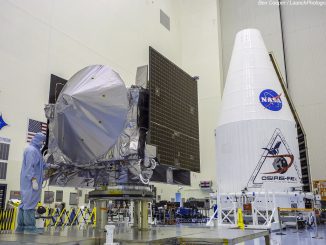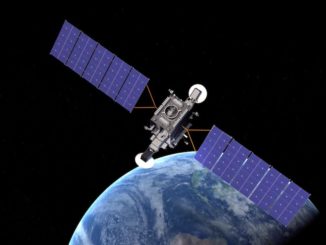CAPE CANAVERAL — An Air Force missile detection spacecraft will, effectively, lose its position in the Atlas 5 rocket’s cramped manifest over the next few months after the flight-worthiness of a thruster on the satellite was called into question and delayed its Oct. 3 liftoff date.
The third Space Based Infrared System Geosynchronous satellite, or SBIRS GEO Flight 3, was supposed to be the next Cape Canaveral mission for United Launch Alliance.
But officials postponed the loading of hazardous maneuvering fuel into the Lockheed Martin-built satellite and deferred its launch in the wake of a parts issue that arose on two other spacecraft programs — the Navy’s Lockheed Martin-built MUOS 5 satellite and a private spacecraft believed to be the Boeing-made Intelsat 33e. Both satellites recently experienced thruster malfunctions during post-launch orbiting raising.
“The Air Force is working to understand the commonality between the two anomalous engines and the SBIRS design,” the service announced Sunday.
A non-disclosure agreement in place between the commercial satellite program in question and the Air Force has prevented officials from publicly confirming the exact mission that delayed SBIRS GEO Flight 3.
But the commercial Intelsat 33e to serve Europe, Africa, the Middle East and Asia, successfully launched by Europe’s Ariane 5 rocket on Aug. 24, experienced a “malfunction in the primary thruster used for orbit raising,” Intelsat announced earlier this month. “Boeing, the satellite’s manufacturer, is presently working with the company to determine the cause of the thruster malfunction.”
The high performance communications satellite will use its other thrusters to make the trek, albeit a slower journey, to geosynchronous orbit 22,300 miles above the Earth. It should enter service early next year instead of later this year.
The Navy has not yet publicly acknowledged any specific details into the situation with the MUOS 5 mobile communications spacecraft, the timetable to recover the mission or even if salvaging the satellite will be possible. After completing an unspecified number of maneuvers following the June 24 launch, an “anomaly” struck June 29 that has rendered the main propulsion system failed.
The Air Force said Sunday that the SBIRS launch “is not expected earlier than January due to launch scheduling and to allow the investigation to continue until the Air Force is satisfied that safety of the satellite is assured.”
That formally moves GOES R, the joint NASA and NOAA civilian weather satellite, to the next East Coast mission for the Atlas 5 rocket. Liftoff is planned for Nov. 4, and officials say its thrusters are not implicated in the on-going investigation.
Attention then turns to Vandenberg Air Force Base where a classified payload — NROL-79 — will be launched for the National Reconnaissance Office on Dec. 1.
A commercial launch is slotted into the Atlas manifest next, on Dec. 8, to deploy the EchoStar 19 broadband internet connectivity satellite for North America.
ULA plans to conclude the year with a Delta 4-Medium+ (5,4) rocket launch of the Air Force’s Wideband Global SATCOM 8 communications satellite on Dec. 15.
The earliest SBIRS GEO Flight 3 could regain a launch slot is January, the Air Force said Sunday. That is when the military currently holds a position on the manifest and could, theoretically, use it for SBIRS.
As it stands today, however, next year is scheduled to begin with the Air Force’s ultra-secure Advanced Extremely High Frequency 4 communications satellite on Jan. 26.
“The SBIRS satellite remains safe at the launch base,” the Air Force statement said.
“To date, the joint government and industry team has reviewed approximately 90% of the design, build, and test data from the anomalies. Additionally, all design similarities between the SBIRS liquid apogee engines and the anomalous engines have been fully documented and are understood. The team expects to complete the investigation within the next couple of weeks.”
SBIRS is the next-generation missile warning system for the United States that continuously watches the globe with infrared vision looking for missile launches and alerting forces of the imminent threat. The first two geosynchronous satellites in the SBIRS constellation were deployed in 2011 and 2013.
“Assured access to space is a prime National Security Space directive. A fundamental part of assured access to space is safely getting our satellites to orbit which is extraordinarily challenging and technical,” Lt. Gen. Greaves, the Air Force’s program executive officer for space, said in Sunday’s statement.
“Ensuring the safety of our national security space assets is critical and we will extensively investigate all possible causes before launching the SBIRS GEO-3 satellite.”




